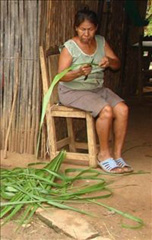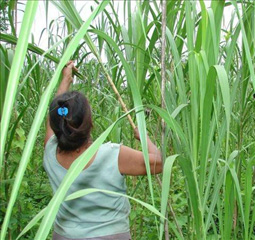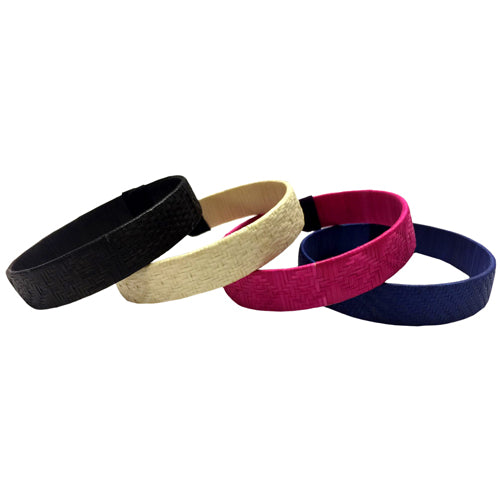OWP
Pulsera Cana Flecha Sólida Tejida a Mano-4 Colores
Pulsera Cana Flecha Sólida Tejida a Mano-4 Colores
No se pudo cargar la disponibilidad de retiro
Caña Flecha es una planta parecida a la caña de azúcar que solo se encuentra en las regiones costeras de Colombia, Sudamérica. La tribu Zenu cultiva las hojas delgadas con forma de tallo utilizando procesos y técnicas que se remontan al siglo XVI y las teje en varios patrones geométricos creando estas pulseras únicas.
Estas hermosas pulseras están elaboradas por algunos de los indios zenúes que quedan en Colombia. Trenzan tiras de caña flecha, que ha sido utilizada por sus antepasados durante siglos. Estas personas son leales a su legado cultural, pero los colonos coloniales los despojaron de sus riquezas, tierras y posesiones. Están utilizando las técnicas de tejido precolombino de sus antepasados para crear joyas con diseños contemporáneos.
Todas estas pulseras de comercio justo tienen 2 extremos terminados para que puedas expandirlas y ponértelas fácilmente en tu muñeca.
Mediciones:
- Extra grande: el ancho es de 2” (50,8 mm)
- Grande: ancho 1” (25,4 mm)
- Mediano: ancho 1/2" (12,7 mm)
- Pequeño: ancho 1/4” (6,35 mm)
Características del producto:
- Las pulseras se abren en la parte posterior para adaptarse a todos los tamaños de muñeca.
- Grandes regalos con una causa para chicos y chicas.
- Teñido de forma natural y tejido con hojas de hierba alta.
- Joyería sostenible y ecológica
Hecho a mano en Colombia e importado de Comercio Justo.
Share
About the Artisans
About the Artisans
 Joyeria Semilla meaning Seed Jewelry is a small fair-trade workshop in the Andean town of Villa de Leyva, Colombia. Girasol Taborda, a local artisan and social entrepreneur, started the workshop in the mid-1990s.
Joyeria Semilla meaning Seed Jewelry is a small fair-trade workshop in the Andean town of Villa de Leyva, Colombia. Girasol Taborda, a local artisan and social entrepreneur, started the workshop in the mid-1990s.
Joyeria Semilla’s objective is three-folds; to create new jobs, revive Colombia's handicrafts sector and to motivate locals to better manage their natural resources. The organization works primarily with socially and economically disadvantaged youths, single mothers and people with disabilities in the area. The company offers free training in product design, technical training and marketing to new members. Joyeria Semilla has trained them in the craft of jewelry-making.

Caña Flecha or “Gynerium Sagittatum” is a locally found palm tree in the regions of the Caribbean coast. The leaves from this plant are used for making jewelry, woven hats, bags and baskets. The Zenú Indians were and their descendants inherited the tradition of picking veins of the green palm leaf for weaving. These veins were made into woven hats and other products for their personal use.
The Zenú culture is said to have existed between 200BC to1600AD. With the arrival of the colonizers in the 16th century, the indigenous community declined of unknown reasons. Today a very small population remains that claims the inheritance of the almost extinct Zenú tribe. Known for their skills in the construction of major waterworks, canals and irrigation system along with being skilled goldsmiths, examples of their accomplished craftsmanship are found in various museums around the world. Their larger means of subsistence were hunting, farming, fishing and trading.
Caña Flecha is found in abundance in the region, and hence makes for a sustainable and naturally available raw material for these products. Every bit of the plant is utilized – from using in building walls and roofs in houses to food for cattle and medicinal purposes. It is from the central vein of the leaf that the fibers for weaving are obtained. After the hard surface is peeled off, the fibers are left in the sun to dry and undergo a natural tinting process; these fibers are barely about 1 millimeter in thickness and hence call for a lot of skill and patience to weave with. The dried fibers are then processed for natural coloration - some are boiled with lemon to whiten them and some are treated with mud and boiled with plantain leaves to blacken them. The designs are based on ancient motifs and mathematical representations, which are inspired by the early Zenú culture.










